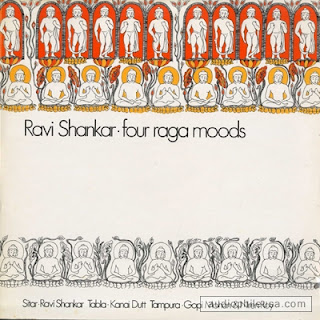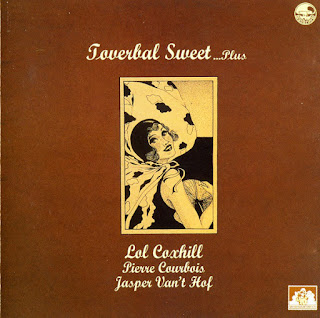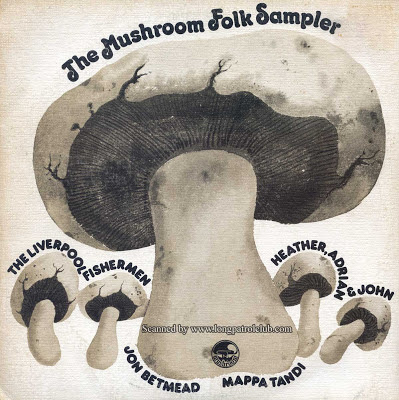Spaced Out: The Story of Mushroom Records
(Grapefruit/Cherry Red CRSEG036D; 77.38, 75.04)
Label retrospectives are released nowadays thick and fast as smog in Poland. Some compilations put together what doesn’t always seem to be linked, but when well-curated and for the first time, like here, they are a welcome addition. Music lovers may have once had originals but can’t now afford due to rarity value. Not the most loved of formats, at least CDs make up in cost and content-size what vinyl can’t do. There have been great retrospectives of famous labels such as Vertigo, Harvest and Dawn, as well as Cherry Red’s own Dandelion catalogue: equally wide-ranging in its eclecticism, this new offering spotlights what may have been missed in those featured genres.
Sixteen albums including a sampler and four singles in just fifteen months, the first CD is a representative selection from all but one (Bach two Bach) of the label’s output as originally priced as the company: £2 an album, less if a debut, £3 for a double, and 50p for a 7”! The first 5 LPs and a single were launched on April 1st (!) 1971, but just two sold fairly well. One was by Second Hand, whom some consider the first-ever prog band, and Ravi Shankar’s double Four Raga Moods, only released in India until Mushroom leased it from EMI with a new gatefold designed by the owner’s wife-to-be Pam Harner. Fungus Productions’ slogan was “Magical mystical music, treat your mind to a mushroom” and certainly lived up to that menu.
Owner Vic Keary started as a producer in 1957 in Farnham Surrey and had a jazz hit in ’61 when working at Maximum Sounds Studio in Dean Street, the premises formerly of one of the first pirate radio stations (Radio Atlanta). It could lathe-cut 78 RPMs, and the technology’s pumping bass was loved by reggae musicians. Maximum sold it to Manfred Mann and moved to east London. In ’69 Keary, and reggae label-owner Emil Shalit, found a former offy vacant next to the Belmont pub in Chalk Farm, opposite the Roundhouse. They were amazed to discover that in the interim it had been the former Rayrick Studio used by Graham Bond, the Surrey beatsters The Nesters (later English group Nectar), The Morells, and Peppermint Trolley. Cream recorded their first single there too produced by Robert Stigwood, as well as tracks that surfaced only on the Sweden release of their debut LP before moving to Mayfair then America. Jack Bruce later said the debut’s N.S.U. song celebrated their first rehearsal at the north London site.
The first released recording by the “friendliest studio in town” was by the Trinidadian 30 year-old Mel Turner (i.e. Jimmy Ross): Jungle Harlem was leased to United Artists (here on CD2), while studio and label were kept afloat by Keary’s reggae hits for Trojan etc including the famous Young, Gifted And Black. Thanks to extended credit from RCA’s pressing plant—Presley and all!—the first-day Mushroom releases were LPs by Ravi Shankar, the local sitar-player Pandit Trikha, Simon Finn, Second Hand, and a Greek folk-singer fleeing from Greece’s military junta whom Melody Maker compared to “the best of Leonard Cohen”. Cover art was limited to one colour, so they chose brown (ah those were the days), and reviews could be late because promos held up in the GPO post! Ads peppered the underground press (Oz, International Times) as well as the mainstream, where they had good reviews, but were ignored by the BBC coinciding with pirate radio stations being outlawed. Mushroom’s engineer started their own in-house Radio Free Caroline (which could be heard in Amsterdam; Holland remained their best market) until it blotted out local television signals and was closed down.
Based thus in London’s counter-culture heartland, shared with Ladbroke Grove, the musical taste reflected their lifestyle. While Second Hand were laying a second album there, doubling as the studio’s session band (their Kieran O’Connor coined the label name), a documentary was filmed but seems to be lost. Andreas Thomopoulos’ producer Neil Richmond initially turned up after being sacked by Abbey Road—for not wearing a tie and then a tie and no shirt to Pink Floyd’s recording session!
Ravi Shankar is absent (doubtless due to licensing issues, as with Deram’s The Quik from CD2) but the ‘world music’ of India is well-represented by the fast raga sitar with tablas of Pandit Trikha, the folk of Natai Dasgupta, and Magic Carpet. The funky steel band from Trinidad, Les Flambeaux, cover Evil Ways that is not actually by Zack, as also misstated on Santana’s album (and later by Type O Negative) but by Sonny Henry. The late Lol Coxhill (1932-2012) adds his avant-garde jazz saxophone (Or Alternatively Nine), around the time of his Ear of the Beholder LP for Dandelion Records before working for Virgin off-shoot Caroline Records and Kevin Ayers.
The ex-Spalpeens’ Callinan-Flynn have two songs from the aptly-titled Freedom’s Lament highlighting twin elements of Irish folk: a rousing full-band rebel anthem and a too-soon-fading ballad complete with recorder, beautiful as that genre often is. Their shelved LP of 1972 as Urban Clearway makes a welcome appearance with an instrumental. Dave Callinan later became well-known as a writer. Two songs by Andreas Thomopoulos are from his 500-copy Greek language Songs of the Street and later collectable Born out of the Tears of the Sun, recalling the excellent Marc Brierley or Mark Fry with added Jews harp (so ethnic it’s been found in 16th century Native Indian burial sites). Swirling atmosphere with rich, earthy vocals.
The singer-songwriter Simon Finn has two tracks from his legendary acid-folk pot-pourri Pass the Distance (Jerusalem; Where’s Your Master Gone?). Going to London in ’67 he soon opened for Al Stewart at the Marquee’s Wednesday Folk Night (entrance a quid: “one could eat for 3 days on that”). The album was withdrawn due to the cover art’s copyright, and a single was aborted. He moved to Canada in the mid-seventies and then was coaxed back to a studio and gigs in 2003, with the help of David Tibet (he played too in Current 93 before they fell out) and another fan, Sonic Youth’s Thurston Moore. The CD’s longest track at nearly 7 minutes, Jerusalem is a strumming, egg-box-shredding holler backed by organ: William Blake it ain’t, but very ‘period’ in the vein of the stream-of-consciousness of Magic Michael. The album has trippy effects by his 20 year-old live-jamming partner, the now acclaimed experimental multi-instrumentalist David Toop (Oceans of Sound etc) though Finn’s LP is missing from Toop’s website. An unearthed gem is the country rock trio Gordon, Ellis & Steele’s Don’t Wait Till The Morning, melancholy lyrics but sunny in the West Coast mode; it was unreleased because at the end of the Mushroom sell-by date.
Three selections appear from The Mushroom Folk Sampler recorded in October 1971 and released two months later, fourteen songs by four acts with studio audience adding to the homely atmosphere. Only one of them got their own LP, The Liverpool Fishermen (Swallow the Anchor in Aug. 1971), born-and-bred Dubliners who relocated their rollicking drinking songs and fine harmonies to Merseyside. Their The Ould Triangle is based on Brendan Behan’s poem, from an LP of classic traditional fare like Foggy Dew and Scottish ballads. The CD includes the traditional High Germany by Mappa Tandi, i.e. Pat Ludford (12-string guitar) and Jim Kenealy (fiddle) who met in ’68 and had, according to the original sampler’s notes, “West End London appearances” at…tube stations! Their ethnic-tinged folk is here augmented by spirited clapping. Another traditional, and gorgeous, song is Lark in the Morning by Heather, Adrian & John, their Appalachian dulcimer sounding very like an auto-harp. Heather Smith and Adrian Bell first performed in early 1971, joined later that year by John MacDonald on bass.
The trilogy is completed by Jon Betmead’s joyous, sing-along version of the Incredible String Band’s Dandelion Blues from their debut. Father of Dom Search, the 6’5” giant was regularly on the BBC’s Country meets Folk programme plying relevant social views like Beau and Bob Dylan who he covered later on the sought-after rarity A Vision of Heaven (Plant Life, 1977). He wouldn’t have been out of place in John Peel’s Dandelion roster with Beau. The sampler should have become more widely known.
Mushroom’s studio band are now seen as one of the first prog bands, Second Hand (formerly The Next Collection) who recorded a debut Reality on Polydor in early 1969. In spite of no support from the-then fledgling label, the Londoners toured Europe several times and garnered a following in France. The name-change was because of another band on Mercury, and their equipment was not new! They came to Vic Leary’s notice after winning a battle of the bands in Streatham with a prize of a demo at Maximum Sound Studio, but was unreleased. Death May Be Your Santa Claus was recorded some time before its April ’71 release (the guitarist had meanwhile left) and now has classic status, singer Rob Elliot being very influenced by Arthur Brown’s vocal style. There are two tracks from the organ-swirling LP (Hangin’ On An Eyelid is cinematic with very ’60s harmonies ending on a xylophone trill) plus a single A-side (Funeral; high vocals augmented with strings, Bowie-like, originally ear-marked as a 45 for Felius Andromeda), and their later incarnation as Chillum (MR 11, Dec.1971), actually a jam session recorded (with spliff sound) in one day. A pity it’s the shortest track on the CD but their Polydor title track and another appears on CD2. Second Hand ceased in 1972, Ken Elliott and Kieran O’Connor (who died of alcoholism in 1991) were then in Seventh Wave, Bob Gibbons tragically committed suicide in 1977.
The group probably most associated with the label has just one title, The Phoenix, no doubt due to time constraints regarding this classic of lysergic, Indian-styled acid folk. Magic Carpet formed in 1971 out of the remnants of Sargam, whose misspelled album on Windmill was in fact a bootleg. Soon after they were joined by singer-songwriter-artist Alisha Sufit (ceiling in Polish, the country of her ancestry but she was born in Hampstead) for the four-piece’s eponymous LP issued in 1,000 copies (without contract!) at the tail-end of the label’s existence, in June 1972. Recorded live by valve-driven analogue without over-dubbing, Sufit also designed the striking cover of Buraq, the winged goddess of Enlightenment.
Magic Carpet were launched at London’s famous 100 Club but with no promotion and Mushroom reaching the end of its shelf-life (their income source of Trojan Records had dried up by then), a spot on the BBC’s Sounds of the Seventies wasn’t enough to save the band either. The folk singer had played gigs with Terry Reid, Fairport Convention, ISB and The Enid at the Marquee, but Magic Carpet along with Mushroom had to call it a day. According to her fascinating interview on Psychedelic Baby (which also includes label-mate John Williams) The Phoenix was written before she joined the band, about the “transforming and resurrecting power of love”. Their album is one of the best examples of sitar acid-folk ever recorded. Alisha Sufit issued a second MC album in 1990 on her own Magic Carpet Records, and has released several recommended solo recordings since.
The second disc is an astonishingly wide-ranging collection of 25 tracks produced by Vic Keary 1962 to 1972, some famous and many little-known but all rare and of the highest standard. The chances of finding new likes and widening existing tastes are legion. Prime ’66 freakbeat includes A&B sides by the Essex mods The Attraction (with a cool solo on She’s A Girl), one penned by The Kinks’ Ray Davies, and a couple of fuzzed singles (but not as much as Dragonfly or Lord Baltimore) by pop-hopefuls Tuesday’s Children. The London 4-piece recorded with Joe Meek as The Prophets, supported Them and Amboy Dukes at the Marquee up to the Cambridge Pop Festival in’69, then morphed into heavy-progsters Czar. Pre-Beatles material include unreleased tracks by The Mark Leeman Five from ’62 and The Cherokees two years later, plus what The Beatles supplanted (Mel Turner’s White Christmas etc) and femme pop by Angelina, a 1965 Fontana single that Wreckless Eric covered, The Carolines’ Love Made A Fool Of Me, and Pye Record’s New Faces. Parlophone (Oliver Bone’s R&B classic Knock On Wood which hit for Eddie Floyd), Columbia and Decca are also featured.
Three cuts by John Williams are aired, from a violin-led Carnaby Street sound and Decca single 1967-68 to Ramblin’ Boy from his same-period Columbia LP. Dreamy chiming guitar, lilting heart-felt vocals, orchestral strings from the album are all present. Not the famous classical guitarist of the same name, he was in The Attraction with his friend Jimmy Page and supported The Yardbirds residency at the Marquee (just up from a pub-club at the corner of Wardour and Brewer streets that first featured electric guitar, by Muddy Waters in 1958) as well as touring with Sonny Boy Williamson. Jimmy Page, with John Paul Jones, feature on Williams’ rare sought-after LP Maureeny Wishfull (1968).
Resurrected is the classic funked-up blues of Alexis Korner, lynchpin of the first-wave of white blues before the soon-famous muscled-in: a King 7” cut of Lightnin’ Hopkins’ staple See See Rider from ’65, complete with honky-tonk piano and guitar solo squeezed into the 2.15, and an unreleased Taboo Man (1963) ornamented with sax, steel drums and stabbing, string-bending guitar. Also present is Denis Couldry, charting his origins from almost feminine-sounding vocals (James In The Basement, Decca Feb.’68), its beefed-up-with-interludes flip-side credited with The Next Collection, to his life in Second Hand and Felius Andromeda.
Couldry penned the latter’s B-side Cheadle Heath Delusions, heavy bass and thumping tubs often on compilations since, here along with the A-side when name-shortening to Andromeda. After The Storm, not by Stray, was the second single released on Cactus Records in mid-72 before becoming a reggae label, fast-paced like Uriah Heep with a choir. For Meditations, a late ’67 issue on Decca, the organ sound of a church was wanted, so the north Londoners decamped to record in Willesden’s St. Gabriels, added choral harmonies, and dressed-up as monks for publicity shots, as they would in those days. The violinist had “freak-out” written on his score for the ending.
Andromeda’s Rainbow Chasing B-side is more mainstream than their earlier fare, ballady with chiming guitars and na-na-na-ing: nice. They always had a Procol Harum influence, but sought to extend the boundaries a bit. The CD’s breadth extends into the first days of proto-prog with Second Hand’s non-Mushroom diet. Acidy guitar strobes, multi-layered with sound effects, flute, yearning violin, overdubbing guitars for a pulsing crescendo in true prog style…in March ’69 (Reality; The World Will End Yesterday). Let’s get one thing straight once and for all, dear young reviewers: The Beatles, Bowie, Zepp or Stones (sacked a month into their first Marquee residency in ’63 for demanding more money) were never in any counter-culture. They were too busy next door in the counting house, their choice, where the media had a key. Mushroom probably couldn’t afford a lock for premises open as a squat, a nexus for artistic vibrancy like in Dublin that housed such motleys as Gary Moore, Phil Lynott, and Dr Strangely Strange.
After closure, the veteran producer Vic Keary returned to freelance studio work leading to Thermionic Culture, one of the foremost audio equipment manufacturers that include Coldplay among their clients. Mushroom briefly came back a quarter of a century later, one with some of Second Hand sessioning, but the venture was never a conglomerate’s tax loss. It was a different age by then, and the patchwork fabric of local hippydom had mostly gone. Now, the catalogue fuels serious-money vinyl collectability. The booklet interests for Keary’s insights and lots of ephemera from a collector. Though the liner notes are good for an overall picture there is an undoubted lack of facts regarding artistes and careers, unlike standard period compilations’ booklets, so much of this review will not be found therein.
Full of energy and diversity highlighting the spectrum of that mind-expanding era, together with before and after, this 46-track first-ever issue of the cult label and producer is a laudable, fascinating insight into a shoe-string evolution spanning the dawn of today’s popular music. And not only for those there at the time but all who have an interest in what was not on Top of the Pops. Presumably, and paradoxically, that might be the majority of us: a recommended journey with an organic menu.
– Brian R. Banks
© Copyright http://www.psychedelicbabymag.com/2017
Array















Hi, I am Rick Gordon from Gordon, Ellis & Steele. Thanks for the great review of our track Don't Wait Till The Morning. Lovely to have our music appreciated after all this time! rgordon@btconnect.com